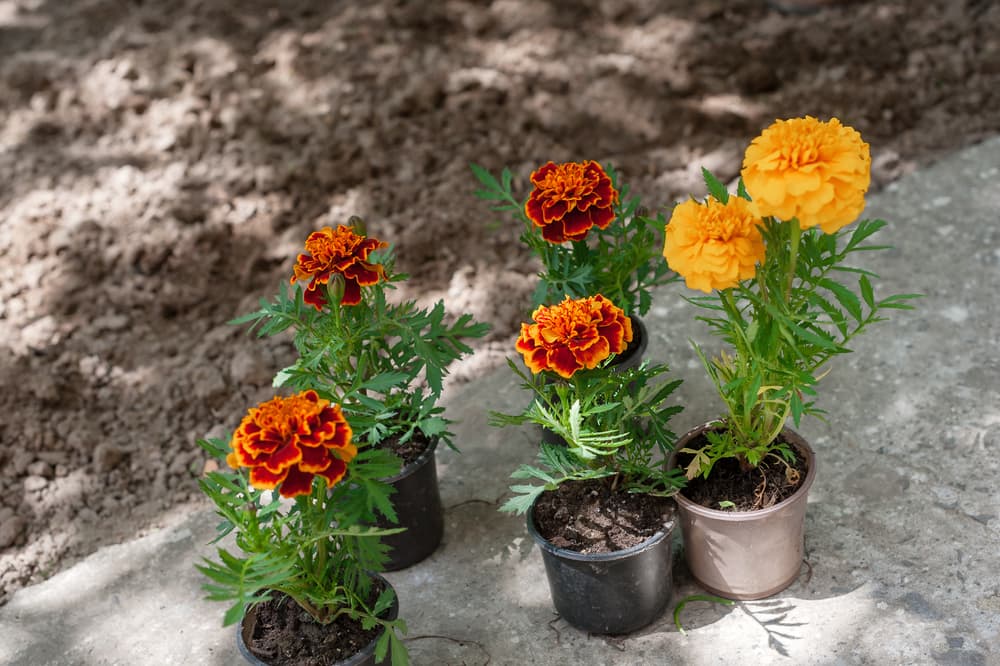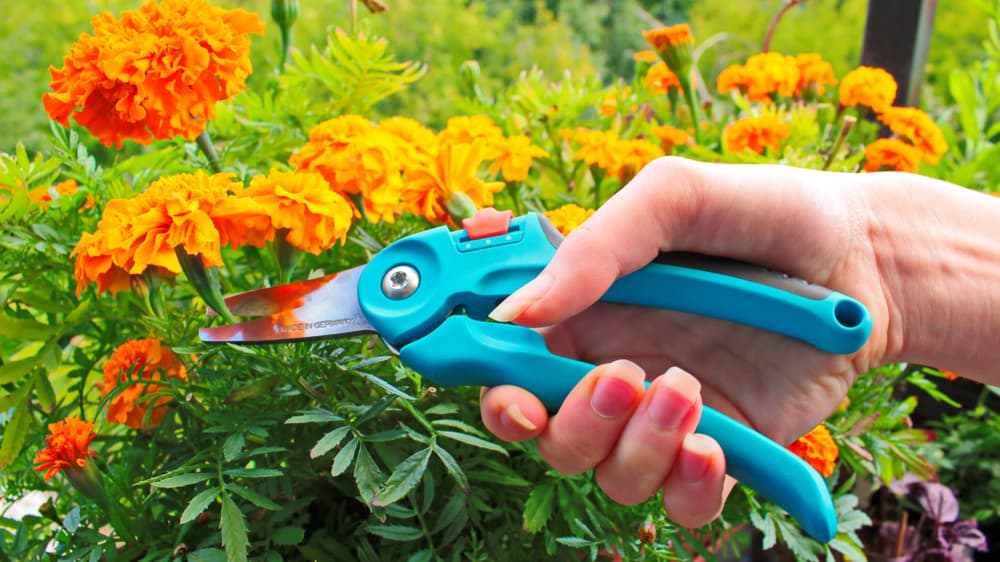ANNUALS > MARIGOLDS
Reviewed By PETER LICKORISH

Peter is a Horticulture Lecturer and self-employed Horticulturist, with a passion for diverse areas of the industry - from garden design to the science behind plant growth and propagation. He has completed the Royal Horticultural Society’s Master of Horticulture (MHort) Award and lectures on RHS courses at Bedford College.
IN THIS GUIDE
MARIGOLDS GUIDES
Marigolds are among the most readily-identifiable of flowers the world over – their rounded, densely-packed, flowerheads in sunny hues from light yellow through gold to red stand out in any garden.
Marigolds are valued not only in gardens but for religious ceremonies in India.1Doctor, V. (2017, October 20). Marigold: The Mexican flower that has become a part of Indian festivals. Economic Times Blog. Retrieved March 21, 2023, from https://economictimes.indiatimes.com/blogs/onmyplate/marigold-the-mexican-flower-that-has-become-a-part-of-indian-festivals/
Nearer home, these easy-care plants are more appreciated for their wonderfully long flowering seasons.

There’s nothing quite like a Marigold – very full and often a little dome-shaped, its multi-petalled double blooms come in warm tones from lemon yellow through gold to near red.
The flowers are good-sized at 5-12cm wide and are also remarkably symmetrical and proportional.
They have a very long flowering season; some varieties get started in mid-spring and continue into autumn.

Those are probably reasons enough that Marigolds are a summer garden staple in so many countries stretching from the Americas through Europe to Australia.2Tagetes. (n.d.). Kew Royal Botanic Garden. Retrieved March 21, 2023, from https://powo.science.kew.org/taxon/urn:lsid:ipni.org:names:325872-2
Another reason is that these herbaceous annuals are easy-grow low-care plants.
The Marigolds that most persons in most regions know and are accustomed to are members of the Tagetes genus.3Tagetes (marigold). (n.d.). Native Plant Trust: Go Botany. Retrieved March 21, 2023, from https://gobotany.nativeplanttrust.org/genus/tagetes/
Overview
| Botanical Name | Tagetes |
| Common Name(s) | Marigold |
| Plant Type | Annual Flower |
| Native Area | South America |
| Hardiness Rating | H2 |
| Foliage | Deciduous |
| Flowers | Daisy-like single or double flowers |
| When To Sow (Indoors) | March, April |
| Plant Out | May, June |
| Flowering Months | June, July, August, September |
Sunlight
Preferred
Full Sun
Exposure
Exposed or Sheltered
Size
Height
0.1 – 0.5M
Spread
0.1 – 0.5M
Bloom Time
June – September
Soil
Preferred
Clay, loam, sand
Moisture
Moist but well drained
pH
Any
Another ‘Marigold,’ usually differentiated by referring to it as ‘Pot Marigold,’ is better known in the British Isles than elsewhere.
This ‘other Marigold’ is from a separate genus: Calendula.
Some of its varieties bear a superficial resemblance to Tagetes Marigolds, hence the confusing naming.
Habitat & Growing Conditions
In their native regions of Mexico, Central America, and South America, Tagetes species grow in and near forests and thickets, near villages, in fields, hillsides, shrubland – in short, wherever it is at all possible for vegetation to grow.4Harris, S. (n.d.). Tagetes species. Oxford University Plants. Retrieved March 21, 2023, from https://herbaria.plants.ox.ac.uk/bol/plants400/Profiles/st/Tagetes
These are tough plants and adapt themselves to a variety of soils and climatic conditions, a fact demonstrated by Tagetes species easily naturalising themselves to numerous regions where they have been introduced, including large swathes of Asia and Africa.

The only habitats they cannot conquer are cold and frigid regions as they are frost-tender with a Hardiness Rating of only H2.
‘African Marigolds’ can and do grow in hotter and dryer locales than their ‘French’ relatives.
How To Grow Marigolds
Marigolds of many varieties are among the most easily-found plants at nurseries and garden centres.
They are commonly sold as plug plants in trays and young plants in small pots.
While brick-and-mortar outlets also sell Marigold seeds, the widest variety of seeds are found online at specialist merchants.

If growing yourself, use a sterile potting mix in small biodegradable pots for easy transplanting and to build in some flexibility.
See our guidelines for growing from seed for more information.
“I find that if you’re going to grow marigolds, you have to commit to them,” shares Master Horticulturist Peter Lickorish.
“I’m not just referring to the attention needed to keep out invading slugs, but also the fact that marigolds do not mingle well with other ornamental plants.

“They’re a great companion crop for vegetables, but I find that in a mixed border, they will get swamped by other plants, especially, in the case of the more delicate, Tagetes patula.
“It is better for flowering displays to devote an area to having a large swathe of them, and they will richly reward you. By the same token, mixing the two main species will usually result in Tagetes erecta dominating.
“To add interest, consider having the odd taller plant dotted among them, such as a dark-leaf Cordyline, to harmonise with their dusky tones.”
Care & Growing Guidelines
Transplant outdoors after there is no danger of frost.
Space the young plants per the spread and needs of the variety in question.
Preferred Aspect
Regardless of whether you sow Marigold seeds directly outdoors or transplant them later, in the UK they should be sited in full sun.
In the sunnier, warmer regions of the country they can be sited where they get filtered or dappled sunlight in the afternoon.
Soil Requirements
The soil should be a light and moderately fertile loam.

Good drainage is preferable and is a must if the soil is at all clayey or otherwise heavy.
For such popular and pretty plants, Marigolds are amazingly low care.
They are unfussy about the type of soil and also the pH.
That said, the plants will perform best if the soil is amended with some organic compost and the pH is between 6.0 and 7.5.

Water them about weekly but more often in dry and hot weather.
Though you do not need to water at soil level, do not allow water to fall on the flowerheads.
As densely packed as they are, they are prone to rotting if they become wet.
Feeding
Marigolds in the ground do not require fertilising after planting but a light feeding of slow-release 0-10-10 fertiliser just before the start of the flowering season will give the blooms to come that added boost.
Do not feed Marigolds with a balanced fertiliser.
Pruning

Some T. erecta varieties have a habit that can only be described as a ‘lanky habit’ (though a few others actually have a bushy habit).
They shoot up, produce a flower, and only then start to branch.
To foster bushy growth, after the plant is about six weeks old, pinch out the leader just above the topmost leaf node.

T. patula varieties are compact and bushy to begin with, and need not (or should not) be pinched.
Regardless of whether or not you pinch a T. erecta variety, keep an eye on it.
If it gets droopy, which can happen at any point in the plant’s life, you should stake it.
Common Problems

African Marigold varieties can be attacked by glasshouse red spider mites and may ‘catch’ powdery mildew.
Glasshouse red spider mites must be taken care of with haste.
The good news is that you have a choice of treatments – newer biological controls include predatory mites and a predatory midge.
Under glass, raising the humidity can help reduce infestations.
It is not only humans who like the piquant taste of Marigolds, slugs and snails enjoy eating them too; at least these pests are not too difficult to control.
Background & Origins
Tagetes species originated from the regions of Mexico and Central America and naturalised in South America and the region of the American South-West, where they are now considered to be native.
Courtesy of the Spanish conquistadors, plants were sent to Europe as early as the Sixteenth Century.

Carl Linnaeus described the genus in his Species Plantarum in the 1750s.
Later, French floriculturists started to develop T. patula in a big way; as a result, colloquially this species came to be called ‘French Marigold’.
References
- 1Doctor, V. (2017, October 20). Marigold: The Mexican flower that has become a part of Indian festivals. Economic Times Blog. Retrieved March 21, 2023, from https://economictimes.indiatimes.com/blogs/onmyplate/marigold-the-mexican-flower-that-has-become-a-part-of-indian-festivals/
- 2Tagetes. (n.d.). Kew Royal Botanic Garden. Retrieved March 21, 2023, from https://powo.science.kew.org/taxon/urn:lsid:ipni.org:names:325872-2
- 3Tagetes (marigold). (n.d.). Native Plant Trust: Go Botany. Retrieved March 21, 2023, from https://gobotany.nativeplanttrust.org/genus/tagetes/
- 4Harris, S. (n.d.). Tagetes species. Oxford University Plants. Retrieved March 21, 2023, from https://herbaria.plants.ox.ac.uk/bol/plants400/Profiles/st/Tagetes


